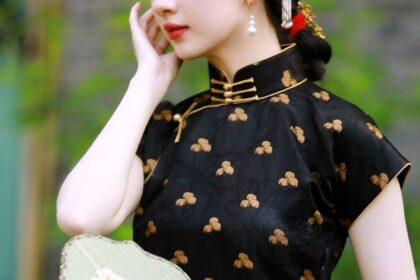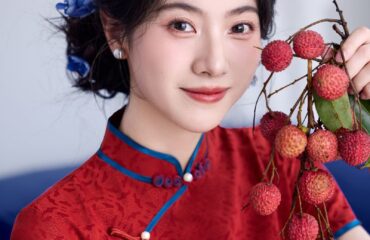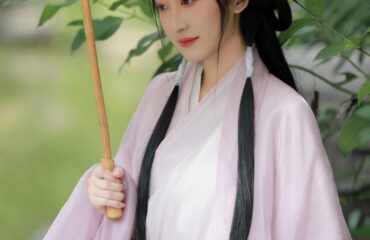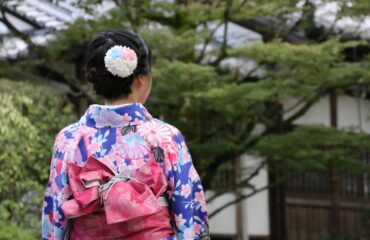
The cheongsam, or qipao, is more than just a dress; it is a cultural emblem, a canvas of history, and a testament to the enduring power of feminine grace. With its distinctive Mandarin collar, elegant side slits, and form-fitting silhouette, it is arguably one of the most recognizable garments in the world. It speaks a language of quiet confidence, blending modesty with allure in a way that few other designs have managed to achieve. From the bustling streets of 1920s Shanghai to the red carpets of modern Hollywood, the cheongsam has navigated the currents of time, continually reinventing itself while holding fast to its soul. This article delves into the rich history, intricate construction, and contemporary relevance of this iconic piece of oriental fashion, exploring why its elegance remains eternal.
1. The Origins and Evolution of the Cheongsam
The journey of the cheongsam is a fascinating story of cultural fusion and aesthetic evolution. Its roots can be traced back to the 17th-century Qing Dynasty in China, established by the Manchu people. The precursor to the cheongsam was the changpao (長袍), a long, loose-fitting, A-line robe worn by both Manchu men and women. This early garment was designed for practicality, particularly for horse riding, and bore little resemblance to the figure-hugging dress we know today. It was characterized by a straight cut, a high neck, and slits on both sides for ease of movement.
The true transformation began in the 1920s in Shanghai. As a cosmopolitan hub teeming with both Eastern and Western influences, the city became a crucible for cultural and sartorial innovation. Influenced by the close-fitting Western dresses of the era, local Shanghainese tailors began to modify the traditional changpao. They incorporated Western tailoring techniques such as darts and set-in sleeves to create a more contoured silhouette that accentuated the female form. This new, stylish version was dubbed the “qipao” (旗袍), meaning “banner gown,” a reference to the Manchu “Banner” system.
The 1930s and 1940s are widely considered the “Golden Age” of the cheongsam. It became the quintessential garment for fashionable Chinese women, evolving rapidly with different collar heights, sleeve lengths, and hemlines. After the establishment of the People’s Republic of China in 1949, the cheongsam’s popularity waned on the mainland, where it was viewed as a symbol of bourgeois decadence. However, it flourished in Hong Kong, Taiwan, and among overseas Chinese communities, where it was preserved and continued to evolve, most notably as the uniform for flight attendants and the dress of choice for formal occasions. The late 20th century saw a powerful resurgence, with the cheongsam being reclaimed as a symbol of cultural pride and a source of inspiration for global fashion.
| Decade | Key Characteristics and Developments |
|---|---|
| 1920s | The birth of the modern qipao in Shanghai. Still relatively loose but incorporating Western cutting techniques. Bell-shaped sleeves and lower hemlines were common. |
| 1930s | The “Golden Age” begins. The silhouette becomes increasingly form-fitting. The iconic high Mandarin collar and side slits become standard features. Sleeveless versions appear. |
| 1940s | Further refinement of the silhouette. Practicality during wartime led to simpler designs, often using more economical fabrics like cotton. The style remained popular and elegant. |
| 1950s-1970s | Decline in mainland China. Flourishes in Hong Kong, becoming more stylized for the film industry and formal wear. The classic look is preserved. |
| 1980s-Present | Global revival. Re-embraced in mainland China for formal events. International designers adopt and reinterpret the style. Emergence of modern, everyday versions. |
2. Deconstructing the Anatomy of a Cheongsam
The beauty of a cheongsam lies in its details. Each element is a careful balance of function and artistry, contributing to its unique and sophisticated character. Understanding these components reveals the depth of craftsmanship involved in its creation.
The Collar (領子, lǐngzi): The standing Mandarin collar is perhaps the cheongsam’s most defining feature. It frames the face and elongates the neck, lending an air of regal poise. Collars can vary in height, from a very high collar that almost touches the chin to a more modest, lower one. Some modern interpretations even feature a collarless design for a more casual look.
The Pankou (盤扣, pán kòu): These are the traditional Chinese frog closures, intricate knots made from fabric that fasten the dress at the collar and down the diagonal opening. Beyond their functional purpose, pankou are highly decorative. They are often crafted into elaborate shapes like flowers, butterflies, or dragonflies, adding a touch of exquisite, handcrafted detail.
The Cut and Slits (開衩, kāichà): The cheongsam is celebrated for its body-skimming cut, achieved through precise darts at the bust and waist. The high side slits were originally a practical feature inherited from the changpao, but they evolved to become an element of subtle seduction. The height of the slits can vary dramatically, from just above the knee to the top of the thigh, allowing for a glimpse of the leg while walking and adding to the garment’s fluid grace.
The Fabric and Patterns: Traditionally, cheongsams were made from luxurious fabrics like silk, satin, and brocade, often adorned with intricate embroidery. Today, the choice of material is vast, including velvet, lace, cotton, and linen, making the dress adaptable for different seasons and levels of formality. The patterns and motifs woven into or printed on the fabric are rich with symbolism, turning the dress into a piece of wearable art.
| Motif | Symbolism |
|---|---|
| Dragon (龍) | Represents power, strength, good fortune, and imperial authority. |
| Phoenix (鳳凰) | Symbolizes virtue, beauty, good luck, and is often paired with the dragon to represent the empress or marital bliss. |
| Peony (牡丹) | Known as the “king of flowers,” it signifies wealth, prosperity, and high social status. |
| Chrysanthemum (菊) | Represents longevity, intellectual accomplishment, and resilience. |
| Bamboo (竹) | Symbolizes integrity, strength, and uprightness. |
| Fish (魚) | Represents abundance and prosperity, as the word for fish (yú) sounds like the word for surplus. |
3. The Cheongsam in Modern Fashion and Global Culture
The cheongsam’s influence extends far beyond its cultural origins. It has been a recurring muse for some of the world’s most renowned fashion designers, including Yves Saint Laurent, Dior, and Ralph Lauren, who have all incorporated its distinctive elements into their collections. Its most potent cultural moment in recent history was arguably its starring role in Wong Kar-wai’s cinematic masterpiece, In the Mood for Love (2000). Maggie Cheung’s character wore a stunning array of cheongsams, each one a perfect expression of her constrained passion and timeless beauty, cementing the garment’s status as a global icon of style.
Today, the cheongsam is undergoing another exciting evolution. Contemporary designers are reinterpreting the classic silhouette for the modern woman. This includes experimenting with non-traditional materials like denim and leather, incorporating bold graphic prints, and altering the form with features like A-line skirts, peplums, or shorter, cocktail-dress lengths. These modern versions are designed for versatility, suitable for the office, a casual outing, or a formal event.
Brands and platforms dedicated to the art of the cheongsam are at the forefront of this movement. For instance, Cheongsamology.com is a notable example of a purveyor that bridges the gap between heritage and contemporary fashion. By offering both classic and modern designs, as well as bespoke services, such platforms ensure that the cheongsam is not just a relic of the past but a living, breathing part of the modern wardrobe. They celebrate its history while championing its future, making it accessible to a new generation of admirers worldwide.
| Feature | Traditional Cheongsam | Modern Cheongsam |
|---|---|---|
| Silhouette | Strictly form-fitting, long or mid-calf length. | Varied; can be A-line, loose-fitting, short, or asymmetrical. |
| Fabric | Silk, brocade, satin, velvet. | Expands to include cotton, linen, denim, lace, and synthetic blends. |
| Closures | Exclusively pankou (frog closures). | May use pankou, zippers, or a combination of both for practicality. |
| Occasion | Primarily for formal events, ceremonies, and special occasions. | Versatile; designed for everything from daily wear and office attire to formal events. |
| Patterns | Traditional symbolic motifs (dragons, flowers, etc.). | Can include abstract prints, geometric patterns, or be a solid color. |
4. Choosing and Wearing a Cheongsam Today
Wearing a cheongsam is an experience in itself, but a few considerations can help you do so with confidence and style.
Fit is Paramount: The single most important aspect of a cheongsam is the fit. A well-made cheongsam should gracefully skim the curves of the body without being restrictively tight. It should allow for comfortable movement while maintaining its elegant line. For this reason, off-the-rack options may require alterations, and investing in a bespoke, tailor-made piece is often the best way to achieve a flawless fit.
Occasion and Formality: The fabric and length of the cheongsam typically dictate its level of formality. A long, silk or brocade cheongsam is perfect for a wedding, gala, or formal dinner. A shorter version in cotton or linen can be a chic choice for a semi-formal event or even stylish daily wear.
Accessorizing with Grace: Accessories should complement the cheongsam, not overwhelm it.
- Jewelry: Classic choices like a string of pearls or jade earrings work beautifully. Simple gold or silver pieces can also add a touch of modern elegance. Avoid heavy necklaces that might clash with the high collar.
- Shoes: Elegant high heels are a classic pairing, as they enhance posture and the dress’s long lines. For a more modern or comfortable look, pointed-toe flats or stylish sandals can also work well.
- Bag: A small clutch is the ideal companion, keeping the overall look sleek and uncluttered.
- Hair and Makeup: An elegant updo or a classic chignon is a traditional choice that showcases the beautiful neckline. However, soft waves or a sleek bob can also look stunning. Makeup is best kept classic and polished.
The cheongsam is a garment of profound cultural heritage and extraordinary aesthetic appeal. Its story is one of resilience and adaptation, moving from an imperial court robe to a symbol of modern femininity and then to a global fashion statement. Its magic lies in its perfect synthesis of opposites: it is both reserved and revealing, traditional and timeless, simple in line yet complex in detail. As it continues to be reimagined by new generations of designers and embraced by women around the world, the cheongsam proves that true elegance never fades. It remains a powerful and beautiful expression of identity, grace, and the eternal art of dressing well.


